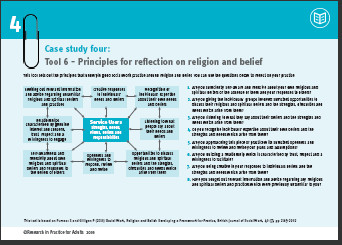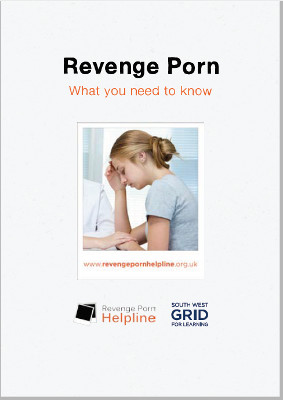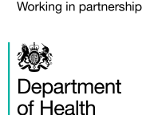Download the whole case study as a PDF file (509KB)
Summary
Emma is a white British woman with a learning disability who is in her early 30s. She lives in a rented accommodation provided by a housing association, but is not currently receiving any social care support.
Emma’s situation has been brought to the attention of social care by the police, who reported a safeguarding concern about Emma’s ex-partner, Darren. Emma has tried to break up with Darren numerous times, but he always ends up living back in her flat with her. His behaviour is putting her tenancy at risk.
This case study concerns issues around supporting people who have a learning disability and are experiencing domestic abuse; financial abuse; and using threats to coerce someone back into a relationship.
When you have looked at the materials for the case study and considered these topics, you can use the critical reflection tool and the action planning tool to consider your own practice.
Case details
Download the case details as a PDF file (550KB)
Emma is 32. She is recorded as having a learning disability and attended a “special school” but does not currently receive any social care services. She lives in rented accommodation provided through a housing association.
Emma is known to the police due to repeated reports by her neighbours. Incidents have involved noise, intimidation of neighbours by visitors, fights between groups of young men and a complaint by Emma that her ex-partner Darren had locked her in the bathroom.
Emma and Darren had been together for five years. Darren moved into Emma’s flat very quickly after they started their relationship, offering to take care of the bills and shopping using a joint account. He said that because of her learning disability she shouldn’t be in charge of the money. At first Emma had enjoyed having a boyfriend and had felt ‘normal’ but he had soon started to just use her flat as he wanted and tell her what to do ‘as if she was stupid’. Darren has taken out a loan in her name and she is receiving letters related to repayments which she can’t afford. Emma used to be really close to her mum who lives nearby, but hasn’t seen her in a while.
The housing association sent Emma a letter saying that she will be evicted if there are any other incidents of her visitors causing distress to other tenants. After the housing association letter Emma ended the relationship. Emma calls herself an idiot for letting him into her life in the first place.
Since the breakup Darren frequently turns up at her flat, banging on the door, shouting and threatening her. Darren is texting her constantly and has threatened to send intimate photos of her to her Dad if she doesn’t let him move back into the flat. He says he knows she will want him back like she has done before. He always seems to know where she is for example, turning up when she goes to the food bank or at the bottom of her Mum’s road.
Following an incident where Darren broke down Emma’s front door the police have raised an adult safeguarding concern. The referral states that Darren is unemployed and does not receive JSA as he failed to actively apply for work. He has two previous offences for possession of marijuana and for theft of alcohol. The referral states that Emma does not want to give evidence to support police action against Darren as she is scared of what he might do to her. She consented to a safeguarding referral being made.
How would you make safe enquiry with Emma?
Who will meet with her?
Where?
How will you contact her to arrange the meeting?
Assessment
In this section are two downloadable PDFs – one is a partly completed assessment form related to this case study, and another is an example of what a completed form could look like.
Suggested exercise
Download the partly completed assessment as a PDF file (494KB)
Download the completed assessment as a PDF file (550KB)
Use the partly completed assessment form:
- What actions would you discuss with Emma to ensure her immediate and longer term safety?
- What precautions would you need to take to avoid putting her at higher risk of harm?
- What is your analysis of the situation? Is coercive control occurring? What is the evidence of this?
- What is your conclusion?
DASH- RIC
Download the blank DASH_RIC as a Word .doc file (226KB)
The purpose of the DASH risk checklist is to give a consistent and simple tool for practitioners who work with adult victims of domestic abuse in order to help them identify those who are at high risk of harm and whose cases should be referred to a MARAC meeting in order to manage their risk. If you are concerned about risk to a child or children, Safe Lives recommend that you should make a referral to ensure that a full assessment of their safety and welfare is made.
There are two downloads on this page.
One shows a blank DASH risk checklist, with quick start guidance from Safe Lives. The key point is to remember that your professional judgement is key in making a decision about risk; a tool can help, but the score it comes out with is not definitive.
This is especially relevant when working with people with care and support needs, for whom some of the questions may not be relevant.
Download the case study DASH-RIC as a PDF file (211KB)
The other shows an example of a completed DASH relating to this case study, for you to critique and appraise.
Suggested exercise:
- Read the case details and full assessment document for this case study.
- Using the information contained, fill out a blank DASH risk assessment tool.
- Discuss how you found it; did you have all the required information? Would you be able to get all the required information in practice? Would you make a referral to MARAC?
Topics
This section picks out three main topics from the case study featured. For Emma’s case study, the topics include:
- Using learning disability as a means of control
- Financial abuse
- Threats to coerce the victim back into a relationship
A selection of references, tools and further reading for each topic is below.
Using learning disability as a means of control
Katrina Pestka & Sarah Wendt (2014) conducted a small study of women with learning disabilities experiencing domestic violence in Australia and ‘found the women in the study had all experienced rejection in their childhoods and sought a sense of belonging in adult intimate relationships, even if they were abusive, and that the women’s low social status increased their vulnerability’. They conclude that ‘women with learning disabilities settle with or accept abuse in their lives to gain social value that has often been missing throughout their life course’.
Other research evidence, including Walter-Brice et al (2012) and McCarthy et al (2015), highlights the severe and sometimes sadistic nature of the abuse of women with learning disabilities, the likelihood of the abuse continuing after the relationship has ended, and the minimal responses of police and social services. A comparison of research available and emerging themes is summarised here:
http://sscr.nihr.ac.uk/PDF/AdultSafeguarding030314/MichelleMcCarthy.pdf
The full research paper reference is available open access (see references, below)
Video
This video features women talking about their experiences and the help that was available to them, with advice from professionals and specialist services.
Don’t Put Up With It! Domestic Violence and women with disabilities (15:26 mins) Tizard. University of Kent
Having trouble with the embedded player? View the video directly here:
https://www.youtube.com/watch?v=qV6vLyaqOgI
Tool 1, below outlines a structure for group reflection using the video above.
Financial abuse
‘This coercive and controlling behaviour can leave women with no money for basic essentials such as food and clothing. It can leave them without access to their own bank accounts, with no access to any independent income and with debts that have been built up by abusive partners set against their names.’ (Howard and Skipp, 2015: 1)
‘It’s hard to do anything without money. You can’t even get on the bus without cash. So I had no chance to leave or even get help.’ (Survivor, Howard and Skipp, 2015: 40)
Marilyn Howard and Amy Skipp’s research into women’s experience of financial abuse is available here:
Howard and Skipp, Unequal, Trapped and Controlled
Social workers need to recognise financial abuse as a barrier to leaving and be knowledgeable about the role of housing agencies in responding to people with care and support needs fleeing coercive and controlling relationships. Liaison with housing agencies regarding tenancy violations which are the partner’s fault may be required.
There are Sanctuary Schemes for households at risk of domestic violence – you can download a practice guide for agencies here:
Sanctuary schemes for households at risk of domestic violence: guide for agencies
Threats to coerce the victim back into a relationship
Such threats can include revenge porn, homicide or suicide threats, stalking and online abuse as a way of coercing the victim back into a controlling abusive relationship. A report from Women’s Aid details the reality of online abuse, harassment and stalking.
Women’s Aid, Virtual world, real fear
Tool 2 outlines practice guidance for supporting people at risk of ‘revenge porn’.
Tools
- Tool 1: Design a ‘learning together’ event
Designing a learning event: Don’t put up with it!
This tool uses a video produced by the Tizard Centre and made with and for women with learning disabilities in the UK. The video describes what domestic abuse is, and explains how people who experience it can get help.
The tool prompts reflection on how the video could be used as a learning tool for people with learning disabilities, carers, and social care practitioners.
- Tool 2: Revenge porn –what you need to know
This leaflet has been produced by Revenge Porn Helpline and South West Grid for Learning. It is aimed at people who have experienced revenge porn, but is also useful for professionals.
Tool 1: Design a ‘learning together’ event

Download the tool as a PDF file
Watch the video in supervision, with peers, or in a team meeting:
*Don’t Put Up With It! Domestic Violence and women with disabilities (15:26 mins) Tizard. University of Kent
Discuss together how this video resource might be used as a learning tool:
| With people with learning disabilities?
Reflection for action: what would you need to consider in preparing for the learning event? |
With carers of people with learning disabilities?
Reflection for action: what would you need to consider in preparing for the learning event? |
With students/ASYE candidates/other professionals/teams?
Reflection for action: what would you need to consider in preparing for the learning event? |
e.g.
|
Reflection on action:
Using feedback from the event, what other strategies might be used to protect people with learning disabilities and others vulnerable to being coerced into abusive & controlling relationships?
Individually
In your team
At organisational level
* Don’t Put Up With It! Domestic Violence and women with disabilities Tizard. University of Kent, shown with permission of the author, Michelle McCarthy
[_/su_spoiler]
Tool 2: Revenge porn – what you need to know

Download the tool as a PDF file (424KB)
This leaflet has been produced by Revenge Porn Helpline and South West Grid for Learning. It is aimed at people who have experienced revenge porn, but is also useful for professionals.
It details
- What revenge porn is
- Where it might be
- The law around revenge porn
- Reporting revenge porn – to the police and to online platforms
- What other action can be taken?
- Further support.
References
Howard M and Skipp A (2015) Unequal, trapped & controlled: Women’s experience of financial abuse and potential implications for Universal Credit. Women’s Aid and TUC.McCarthy M, Hunt S and Milne-Skillman K (2015) ‘I know it was every week, but I can’t be sure if it was every day: domestic violence and women with learning disabilities’. Journal of Applied Research in Intellectual Disabilities. Available online: http://onlinelibrary.wiley.com/doi/10.1111/jar.12237/pdf
Walter-Brice A, Cox R, Priest H and Thompson F (2012) ‘What do women with learning disabilities say about their experiences of domestic abuse within the context of their intimate partner relationships?’ Disability and Society, 27, 4, 503-517.








